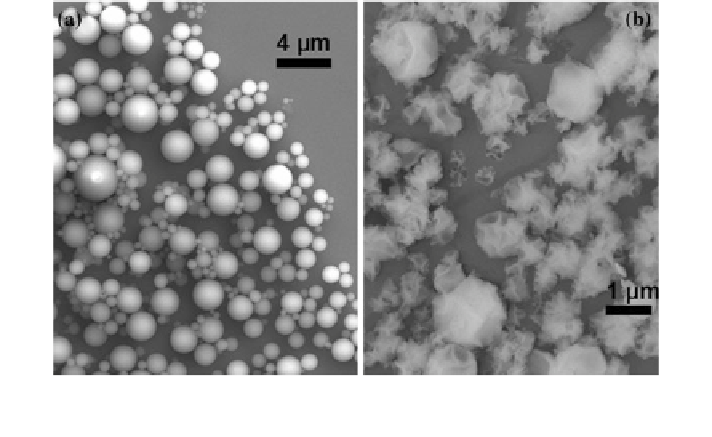Environmental Engineering Reference
In-Depth Information
Fig. 5 SEM image of a as-synthesized microcapsules of NPG in silica shell, and b wrinkled
silica shell after removal of NPG [
32
]
consumed by the hydrolysis of TEOS. These microcapsules are dried in a vacuum
oven to remove the residual ethanol.
The SEM image of the NPG-silica microcapsules is shown in Fig.
5
a. It can be
seen that these microcapsules are spherical in shape with smooth surface. The
diameter of these microcapsules is in the range of 0.2-4 lm. The NPG micro-
capsules have a relatively wider size distribution due to the large viscosity of the
aqueous phase, NPG solution [
33
]. After removing NPG from the microcapsule,
the silica shell collapses without rupture on the shell, as shown in Fig.
5
b. The
flexibility of the silica shell is due to its thin thickness, about 30 nm.
3.5 Phase Change Behavior of Heat Transfer Fluids
with Microcapsules
The effective heat capacity of heat transfer fluids can be enhanced by dispersing
appropriate PCM particles into them. Figure
6
shows the DSC curves of the PAO
dispersion with 20 wt% of paraffin microcapsules. PAO has been widely used as
dielectric heat transfer fluids and lubricants. It remains oily in a wide temperature
range due to the flexible alkyl branching groups on the C-C backbone chain, but it
has relatively poor thermal properties. The overall latent heat of the fluid is
measured as 23.5 J/g. The effective specific heat capacity is about 3.37 J/g k when
the temperature difference between the heat transfer surface and the fluid is
assumed to be 20 C. This value indicates a more than 50 % increase in effective
heat
capacity
in
the
microcapsule
dispersions,
compared
to
the
pure
PAO.

Search WWH ::

Custom Search